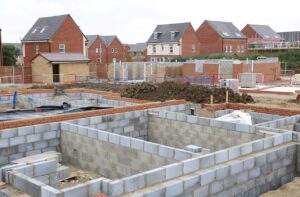2022 predictions for the small-scale property development market


By Ritchie Clapson CEng MIStructE, propertyCEO
As we started yet another year filled with a heady mixture of hope and Covid restrictions, it’s probably a good time to dust off the crystal ball and have a thought or two about what might happen in 2022 in the world of small-scale property development.
Materials
One of the most publicised property development challenges in 2021 was an increase in the cost of materials, with plasterboard becoming the builders’ equivalent of lockdown toilet roll. Many experts are predicting that the cost of cement, concrete, and bricks won’t fall significantly until the mid-year point, while timber and steel prices are likely to settle down earlier, perhaps by the end of the first quarter. A lot depends on suppliers being able to rebuild their inventories, but if you’re at the start of your development journey, then there’s a fair chance prices will have returned to within 10% of ‘normal’ levels by the time you need to order them.
Planning
Under Robert Jenrick’s stewardship, we saw a simplified yet draconian proposal to repair the planning system and build more stuff. Land throughout the country was to be allocated one of three designations:
- You can’t build anything.
- You need planning permission.
- Build what you like.
The problem is that major planning overhauls require a scalpel rather than a cleaver. Council planning officers don’t like power being taken away from them and so talk loudly about the new rules allowing rogue developers to build whatever they want to the detriment of the local population.
We now have that redoubtable heavyweight, Michael Gove in charge of housing and planning reform. So far, he’s not been heavy on the details when it comes to what the revised planning reforms will look like. But what we DO know is that he’s passionate about building on brownfield and that he likes the idea of locals influencing planning decisions. So, we can probably expect a compromise, one that’s going to offer something to (hopefully) better-resourced local planning departments, appeasing the nimbyists while allowing the country’s potential million-plus brownfield units to be built.
Linked to this, there’s the weighty matter of Permitted Development Rights (PDRs). These were significantly reinvented in 2015 and are supposed to provide a much-needed shortcut through our woeful planning system. Since April 2021, all permitted development schemes have had to comply with national space standards and the provision of adequate natural light. So, no more dark rabbit hutches.
It seems likely that Gove will continue to use PDRs as a means to convert brownfield commercial property into residential. There’s a solid logic to the argument; by recycling property and building more homes in our town centres, we create a knock-on demand for local businesses: cafes, pubs, restaurants, mini-marts, boutiques, and so on. This breathes life into high streets, which have been struggling for years. And with so much unused brownfield stock available, it surely makes sense to recycle it rather than ignore it and build on green belt land instead.
Housing market
With many homeowners re-evaluating their home circumstances and work/life balance, there’s been much speculation about the market’s direction of travel, and despite numerous gloomier forecasts, prices continued to climb through November 2021, standing 10% higher than a year previously. Many pundits are predicting a 5% market increase in 2022 and a ‘return to normality’.
An anticipated rise in interest rates coupled with more properties coming onto the market will shift the balance of power away from sellers. With market props such as stamp duty holidays conspicuous by their absence, a more ‘normal’ year sounds like a reasonable prediction. Unknowns—perhaps an Omicron scion—could yet prove influential, but overall a less buoyant market seems likely, albeit one with no massive price adjustments in prospect. Most predictions expect that 2023 will have higher house price inflation than 2022.
For developers, the impact of house price changes is relevant but often not crucial, assuming there are no significant adjustments on the horizon. Plus, of course, the time lag in delivering a new development will push sales into late 2022 or 2023. A more relevant consideration may be what to build and where, as the shopping list for some house buyers in 2021 changed significantly. A work-from-home space, a garden, and healthy broadband speeds featured on the post-Covid shopping list, as did a move towards more rural locations. Whether these will prove to be a temporary blip remains to be seen; however, your local estate agent will be able to give you a good steer.
ABOUT THE AUTHOR
Ritchie Clapson CEng MIStructE is a veteran property developer of almost 40 years and co-founder of propertyCEO, a nationwide property development and training company that helps people create a successful property development business in their spare time. It makes use of students’ existing life skills while teaching them the property, business, and mindset knowledge they need to undertake small scale developments successfully, with the emphasis on utilising existing permitted development rights to minimize risk and maximize returns.


